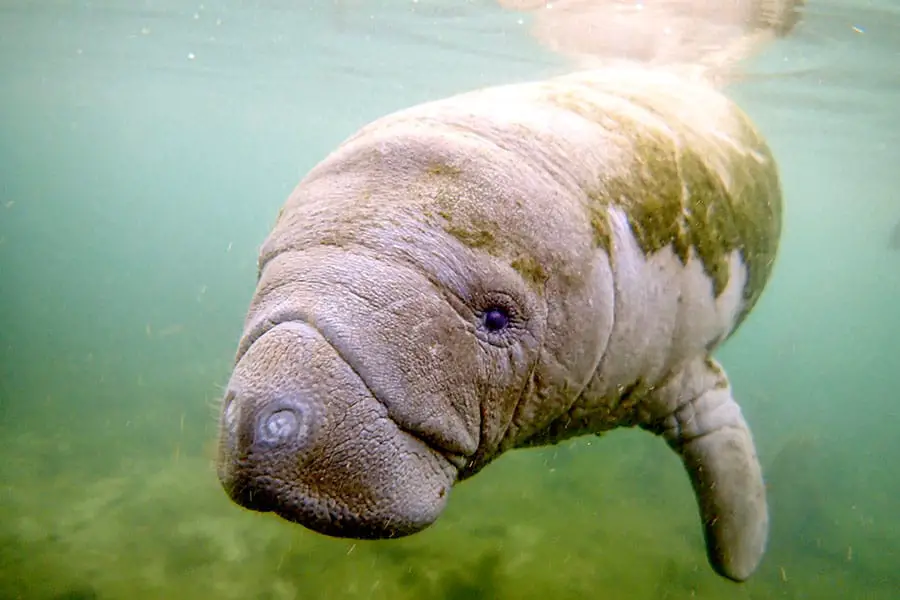
The manatee is a fascinating animal. These marine mammals are known to be curious and docile, darting out from cover to investigate passing boaters or swimmers or even roaming the waterways in groups. Do manatees live in Florida?
Manatees are found in Florida, both in the wild and in captivity. These creatures can be found in almost any marine environment along Florida’s coastline, moving comfortably between the saltwater of the ocean, the brackish waters of estuaries, and the fresh water of rivers.
So, where can you see a manatee in the wild? Are they hard to find? Are some seasons better than others to see manatees, and how close are you allowed to get to them? Learn the answers to these questions about manatees and discover if they are dangerous.
Manatees: Florida’s Other Mascot
The manatee — sometimes known as the sea cow —is a large marine mammal found in warm waters. Manatees live in the Gulf of Mexico, the Caribbean Sea, the Amazon basin, and parts of West Africa. These beautiful and docile sea creatures spend their days eating plants beneath the surface of the water and enjoying a peaceful existence.
While most manatees prefer to stick to saltwater or freshwater, Florida’s manatees are more diverse. The Sunshine State’s sea cows move between the salt waters of the Gulf of Mexico and freshwater rivers. However, they are comfortable in almost any marine environment with warm water.
While manatees can be found almost anywhere along the coastline of the Florida peninsula, there are a few spots that are better for manatee watching. The ideal place is near an estuary with warmer water and plenty of underwater vegetation. The sea cow can consume about 120 pounds of vegetation in a single day, so access to adequate food is a big concern for these aquatic grazers.
One of the best manatee spots in Florida is Crystal River. Located only about 90 minutes north of Tampa, Crystal River has a vast network of springs, estuaries, and rivers that feed into the Gulf of Mexico. If you want to see a manatee, you should rent a kayak and explore the river. Manatees love this area of the state, and there is a good chance you’ll spot one of these beautiful animals in the wild.
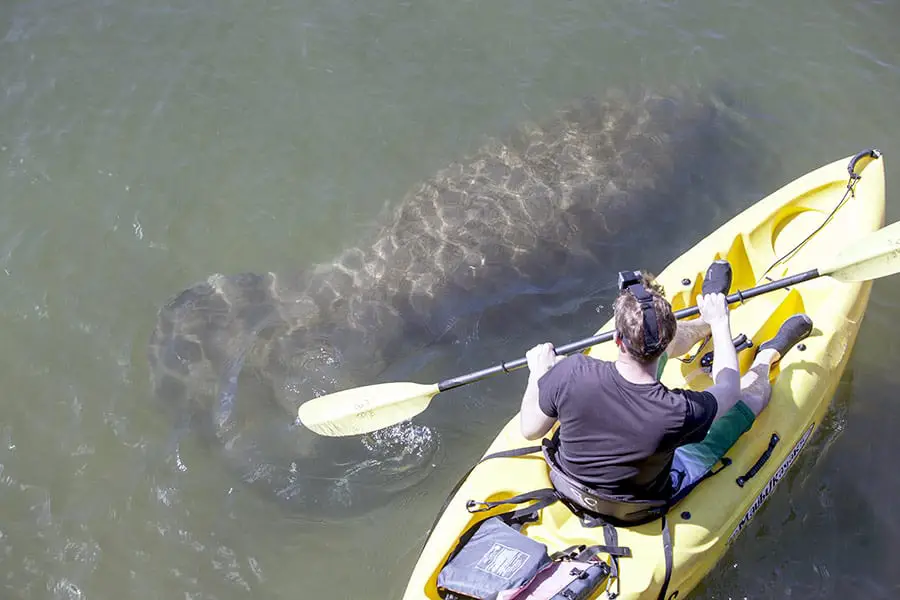
Just south of Crystal River is another excellent manatee spot, the town of Homosassa Springs. Getting out on the Homosassa River in a boat or a kayak is a perfect way to spot manatees in the wild. However, if you have a motorized boat, be extra careful in manatee areas: prop strikes or collisions can kill manatees.
On a lighter note, while you’re in Homosassa Springs, you should check out the wildlife at the Ellie Schiller Homosassa Springs Wildlife State Park. There is a (captive) hippopotamus.
So that’s two great manatee spots on the west coast, but what about Florida’s east coast? One of the premier manatee-watching locations on the east coast is the Merritt Island National Wildlife Refuge, located near Cape Canaveral. Manatees congregate in this refuge year-round, so it is an ideal place to encounter one of these unique and beautiful sea creatures. If you time your trip right, you could potentially watch a rocket launch and see a manatee at the same time.
Phenomenal Florida Fun Fact: Manatees breathe air but are expert divers. They have been known to stay submerged for more than twenty minutes.
During the winter months, manatees usually migrate inland in search of warmer waters. They travel to bays, rivers, springs, and other inland locations through rivers and springs. While manatees don’t usually gather in large numbers, they will share winter habitats with other manatees and can often be seen en masse in favorable winter water conditions. Waters below 60 degrees Fahrenheit are lethal to manatees, so they have a solid motivation to find warmer waters.
With Florida being so warm, could manatees beach and bask out of the water to warm up? Can manatees live on land? While a manatee could probably breathe adequately on land, they would not be good at much else. Manatees are built for the water and cannot survive on land.
In the water, however, the manatee is beautifully agile. Their lungs sit along their backs, allowing manatees to use their lungs for buoyancy control to float or dive. Their large flipper enables them to do spins, somersaults, and other graceful maneuvers while underwater. A manatee’s flippers have a similar bone structure to a human hand, which actually lets them hold and manipulate objects in their flippers.
When is the Best Time to See Manatees in Florida?
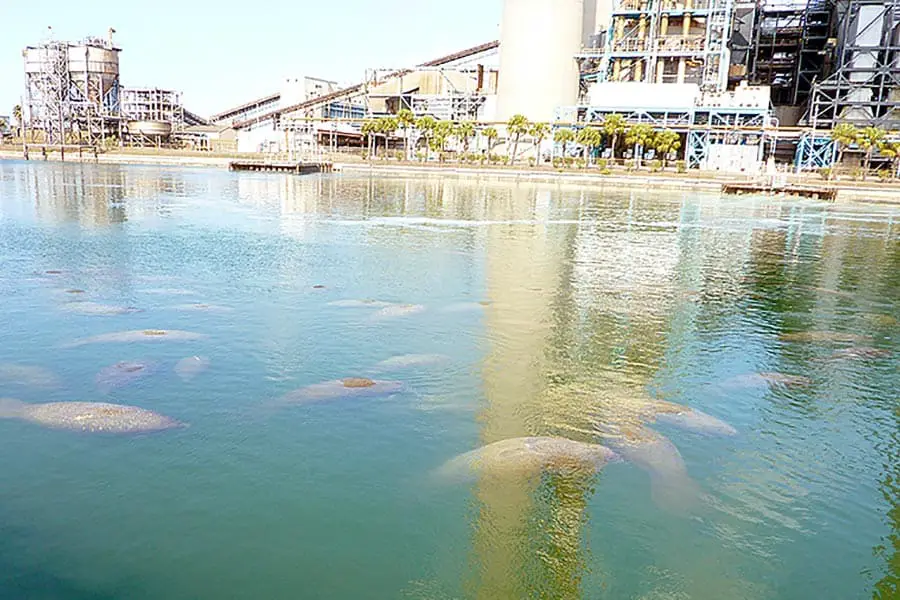
Manatees are most active from November through April, although you can spot them year-round. Cold water is dangerous to manatees, so during the cooler months, they stick to the warmer waters close to shore or inland. Their love for warm water causes manatees to congregate near coastal power plants, where excess hot water from power generation vents into the ocean. The Big Bend Power Station in Apollo Beach has a special viewing area and nature park where visitors can spot manatees, dolphins, sharks, and other marine life attracted to the plant’s warm-water discharge.
Other Posts of Interest
- Are There Deer In Florida?
- Where Do Panthers Live In Florida?
- Does Florida Have Pythons?
- Is Red Tide A Problem In Florida?
Is the Florida Manatee Endangered?
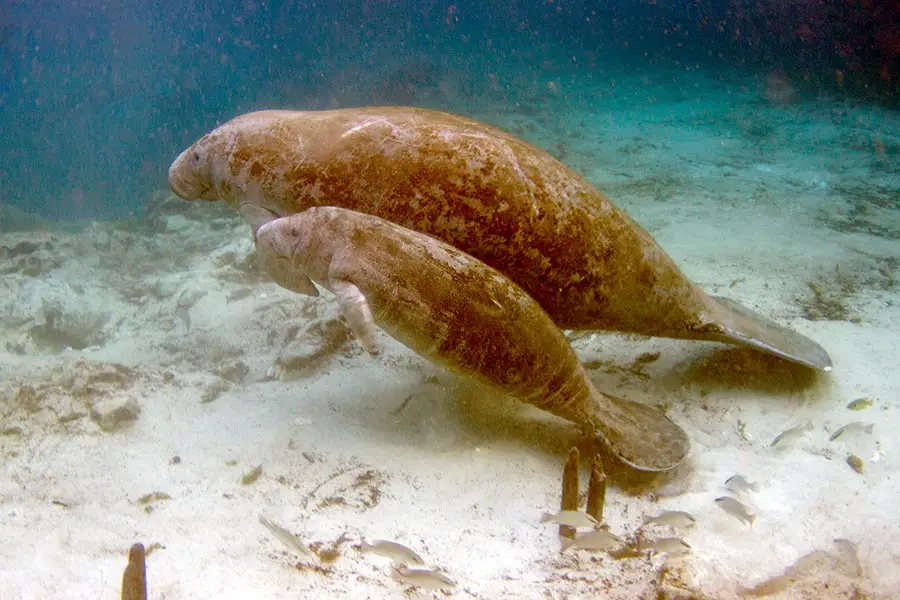
The Florida manatee was endangered for a long time. However, conservation efforts have led to an increase in the wild manatee population, so the species is now considered only threatened. The United States Fish and Wildlife Service (FWS) estimates that there are about 6,500 manatees in the United States and a total manatee population of around 13,000 individuals in Florida and the West Indies.
Manatees are protected in Florida. The Florida Fish and Wildlife Commission has printed clear and concise guidelines on how to interact with manatees. First, you should observe them from a distance and leave them alone. If their behavior changes, for example, if it begins making erratic turns or stops feeding, you are too close.
Locals, and more importantly, local law enforcement, take these guidelines seriously. You can be arrested for touching or harassing manatees. So look, but don’t touch.
What is the Average Lifespan of a Manatee?
Manatees in the wild can live fifty to sixty years. The manatee has no natural predators and usually enjoys a peaceful existence. However, they are highly susceptible to cold-water death, and during particularly frigid years, many individuals perish due to a loss of their natural warm-water habitats. Manatees are also vulnerable to boat accidents, and about 22% of manatee deaths every year are related to collisions with boats and barges.
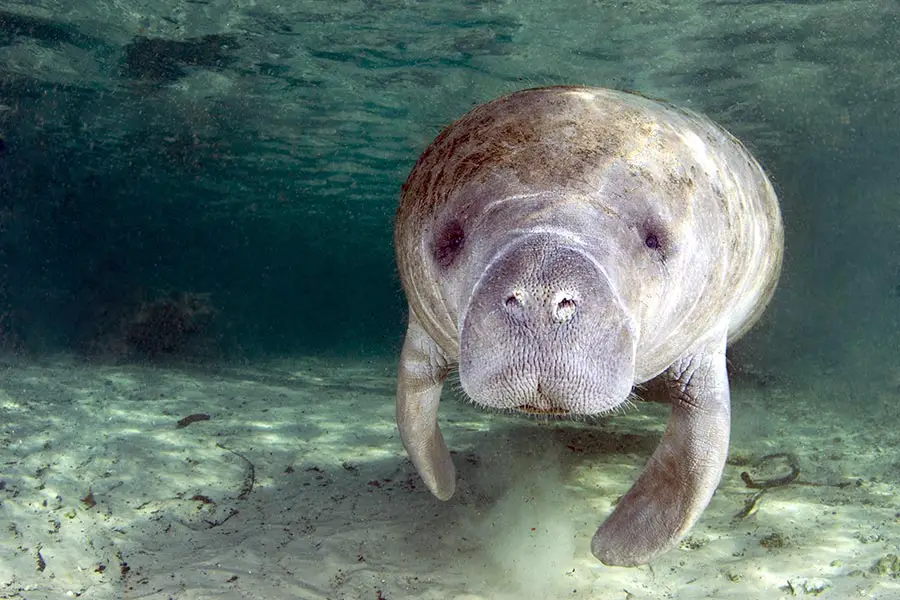
Are Florida Manatees Dangerous?
Florida manatees are known for their docile nature and are not naturally aggressive. Their mouths have rows of molars designed for grinding plants, but they don’t have incisor teeth to bite with. They weigh anywhere from 450 to 1,300 pounds, and they are strong swimmers, but they’re not known to hurt people.
However, just because they aren’t dangerous doesn’t mean you can play with them. Manatees are protected by law, and touching them is a misdemeanor crime in Florida. In addition, in Florida, Fish and Wildlife agents are sworn police officers with arrest powers, and they will not hesitate to enforce the law. So if you are caught harassing the manatees, you will end up in jail.
The best way to enjoy manatees is to look at them from a distance – manatee watching (and wildlife watching in general) is a perfect excuse to buy some new binoculars.
Are Manatees Intelligent?
At first glance, you might not think the manatee is very bright. And an animal nicknamed a “sea cow” doesn’t exactly sound intelligent. However, scientists have found that manatees are almost as smart as dolphins. So it turns out that these majestic sea creatures are more intelligent than we might assume.
Their brains, although relatively small, have unique areas that process information from special hairs on their bodies known as vibrissae. The vibrissae act as sensory organs and provide the manatee with a wealth of information about their environment.
Life in the Slow Lane
The manatee is a remarkable creature. While manatees might seem dim and boring on the surface, these gentle beasts are actually quite lively and fun when you see them in person. Seriously threatened by habitat loss and human activity in the early 1990s, manatees have made a good comeback and are hopefully on the road to recovery.
Next time you are near one of Florida’s great manatee spots, do yourself a favor and take the time to look for a manatee. Head out on the water if you can, and bring polarized sunglasses – they help you see the manatees against the water. Taking the time and energy to find and observe these creatures is always a rewarding experience.





